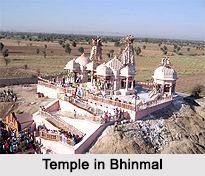 Bhinmal is a town in the Jalore District of Rajasthan. This temple city of Rajasthan was built in the ancient time. If one can travels through the lanes and avenues, he or she can cross the royal Rajasthani cult in the havelis and temples that dated back during the Battle of Tarain in 1192 AD.
Bhinmal is a town in the Jalore District of Rajasthan. This temple city of Rajasthan was built in the ancient time. If one can travels through the lanes and avenues, he or she can cross the royal Rajasthani cult in the havelis and temples that dated back during the Battle of Tarain in 1192 AD.
Location of Bhinmal
Bhinmal is around 45 km in south of the Jalore. The name "Bhinmal" is derived from the word `Shrimal`
History of Bhinmal
History of Bhinmal suggests that this ancient city is the birth place of the popular Sanskrit poet Magh. The further earlier name of the town was Bhillamala. Bhinmal was the capital of Gurjara kingdom. As per the history of Bhillamala, the king of the place was a Kshatriya who was celebrated for his wisdom and virtue and he was a believer in Buddhism and he was considered as a man of exceptional abilities. During the rule of the Kshatriya king, the people of Bhinmal were flourishing. At that time, Brahmanism dominated the city and there was only one Buddhist monastery with 100 brothers. Historical accounts also suggest that Bhinmal town had four gates. In the north, there was Jalori gate, in the south there was the Laxmi gate, in the east there was the Sun gate and in the west there was Sanchori gate.
Historical Importance of Bhinmal
There were several temples of Ganapatis, Kshetrapalas, Chandikadevis, Shivalingas and others. The temple of Bhinmal known as Jagatsvami was one of the earliest and most famous temples of Rajasthan. The temple had beautiful archway. The temple was perhaps built during the reign of Gurjara Pratiharas who were sun worshippers.
Festival in Bhinmal
A festival was held at the temple of Bhinmal in the Hindu calendar month of Asvin. There were a number of Jain temples too, temple of Mahavira being the most famous. The Mahavira temple was constructed by king Kumarpal and was founded by Acharya Hemachandra. It was dedicated to the first Jain Tirthankar Lord Rishabha Dev.
Bhinmal as a Medieval Learning Centre
Bhinmal was a great centre of learning in the early phase of medieval era and the later time of ancient era. The scholars of this ancient city were popularly known far and wide for their research and learning. The well known astronomer Brahmagupta lived most of his life in Bhillamala during the empire of Harsha. Further, Brahmagupta was the head of the astronomical observatory situated at Ujjain, Madhya Pradesh. During his tenure as the head, he wrote two texts on astronomy and mathematics - Brahma Sphuta Siddhanta in 628 A.D and the Khandakhadyaka in 665 A.D. Moreover, the author of Sisupalavadha also lived here in 680 A.D. Bhinmal city was completely ruined in 8th century by the Arab invaders under Mohammad Bin Quasim, because of which even the origin of the ruling Gurjars is not available, and history seems to be quite dark. Several historical journals like `Kanhadade Prabandha` provide descriptions on the Islamic attacks on Bhinmal, popular ancient town of India.



















